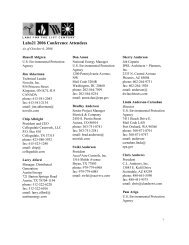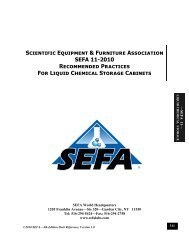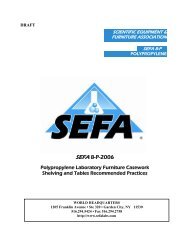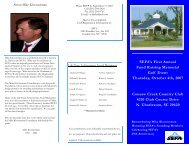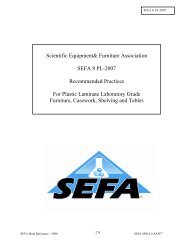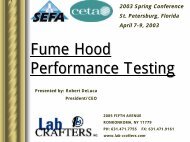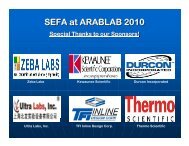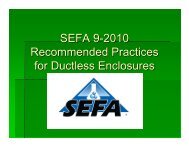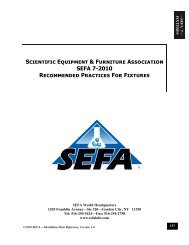Download SEFA-9-2010-Ductless.pdf - Scientific Equipment and ...
Download SEFA-9-2010-Ductless.pdf - Scientific Equipment and ...
Download SEFA-9-2010-Ductless.pdf - Scientific Equipment and ...
- No tags were found...
You also want an ePaper? Increase the reach of your titles
YUMPU automatically turns print PDFs into web optimized ePapers that Google loves.
mination of HCL, if FTIR or an ion chromatograph<br />
is not available. Continuous sampling of<br />
the exhaust for acid detection can be made by<br />
using a small pump to pull the exhaust sample<br />
through a general acid colorimetric tube for the<br />
purpose of acid detection, at the rate of approximately<br />
1.5 l/min. When the general acid<br />
colorimetric tube begins to turn pink begin<br />
sampling exhaust with HCL acid colorimetric<br />
tube, 1-10 ppm, to determine the exhaust concentration.<br />
Follow manufactures sampling recommendation<br />
when sampling with the HCL<br />
acid 1-10 ppm tube.<br />
Exhaust air from the hood must be sampled at<br />
15 minute time intervals. For sampling of HCL<br />
acid using colorimetric tubes, sampling must<br />
begin two hours before the end point of the test<br />
is achieved. For hoods which incorporate a secondary<br />
filter means, the exhaust of the primary<br />
filter bed ONLY will be sampled, not the exhaust<br />
of the hood itself. Continue evaporation<br />
<strong>and</strong> exhaust sampling until chemical concentration<br />
equals the inlet concentration or the TLV,<br />
whichever is lower. For each data point, record<br />
or calculate the mass of chemical evaporated as<br />
well as chemical concentration levels in the<br />
sampled air streams. Sample <strong>and</strong> record room<br />
concentrations at a sampling point one foot out<br />
from the center point of the sash. In cases<br />
where the time of testing goes beyond 8 hours,<br />
the hood <strong>and</strong> test apparatus shall be turned off<br />
<strong>and</strong> left in a stagnant mode until the next testing<br />
period. During this stagnate mode, the hood<br />
shall be disconnected from any active exhaust<br />
systems to prevent airflow through the filters.<br />
At the beginning of the next test period record<br />
<strong>and</strong> graph all data. Be certain chemical containers<br />
are sealed to prevent evaporation. The test<br />
output shall be a table or graph of the mass of<br />
the test chemical evaporated plotted as the x-<br />
axis vs. the concentration in ppm of the chemical<br />
concentration found in the hood exhaust on<br />
the y-axis. Conditions of the test are to be provided<br />
on the graph or separate list that includes<br />
temperature <strong>and</strong> humidity of the test room,<br />
CFM <strong>and</strong> face velocity, evaporation rate, grade<br />
<strong>and</strong> concentration of the chemical, current<br />
listed TLV, start <strong>and</strong> stop of the test, amount of<br />
filter media <strong>and</strong> type, method of evaporation,<br />
inlet concentration <strong>and</strong> total test time. The<br />
name <strong>and</strong> model number of the unit tested is<br />
also to be provided with the report.<br />
4.3.2 Independent testing <strong>and</strong> validation<br />
The manufacturers’ benchmark testing as described<br />
in 4.3.1 shall be validated by an independent<br />
recognizable third party. Manufacturers<br />
should include a copy of the third party<br />
testing in their technical manual.<br />
4.4 Markings<br />
<strong>Ductless</strong> Hoods should be clearly identified<br />
with the words “DUCTLESS HOOD” prominently<br />
displayed in large letters on the front of<br />
the product in order to differentiate them from<br />
conventional ducted Fume Hoods.<br />
DH ratings, identified in this work practice as<br />
DH I, II <strong>and</strong> III, should also be prominently<br />
displayed in large letters on the front of the<br />
product, along with reference to <strong>SEFA</strong> 9. The<br />
DH I <strong>Ductless</strong> Hood label should contain a<br />
message noting their inability to provide protection<br />
for anything other than nuisance odorous<br />
compounds. The DH II <strong>Ductless</strong> Hood<br />
label should contain a message requiring the<br />
immediate suspension of usage at the time of<br />
saturation detection.<br />
An area on the <strong>Ductless</strong> Hood should be provided<br />
in plain view for the placement of form<br />
<strong>SEFA</strong> 9-A. If removed the form shall let the<br />
following words appear: “NOT RECOM-<br />
MENDED FOR USE WITHOUT CURRENT<br />
APPLICATION APPROVAL FORM <strong>SEFA</strong> 9-<br />
A IN PLACE.”<br />
A sticker stating the recommended sash/door<br />
position should be placed on the enclosure.<br />
The label should also indicate if the ductless<br />
hood is only able to achieve <strong>SEFA</strong> 9 containment<br />
compliance in a specific position.<br />
The filtration device type <strong>and</strong> name should appear<br />
in plain view <strong>and</strong> be easily identifiable by<br />
the operator.<br />
—<strong>SEFA</strong> 9—<br />
DUCTLESS<br />
©<strong>2010</strong> <strong>SEFA</strong>—4th Edition Desk Reference, Version 1.0 305



